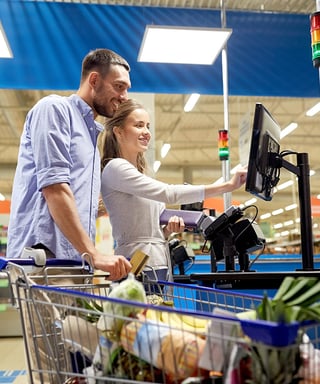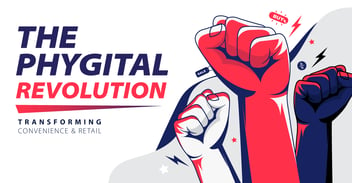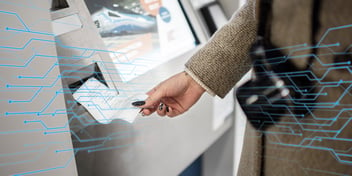3 Ways Convenience & Retail Can Go "Phygital"
Self-service and digital experiences have become the standard for today’s consumers. And, with over 80% of the US population sporting smartphones, it’s hardly surprising to see so many customers turning to self-checkout, online ordering, and e-commerce. Nearly 85% of worldwide e-commerce sales are performed on a smart device.
Despite this exponential growth in “m-commerce” a surprising number of the younger generation prefer to mix their mobile ordering with in-store experiences. Over half (67%) of Gen Z actually prefer to shop in brick-and-mortar locations while 98% find themselves taking advantage of in-store convenience. But their idea of an ideal shopping experience is a far cry from previous generations.
Rather than avoiding smartphones and self-service in favor of in-store retail, younger consumers expect their technology to be a cohesive part of their brand and shopping experience. They want self-checkout, online inventory and location information, and more. So, how can convenience stores and retailers leverage digital adoption for their in-person retail stores? Here are three ways to mix digital with physical for retail “phygital” success.
Make purchases easier, whether cash or card.
One of the biggest loyalty application successes can be awarded to Starbucks. The mega coffee chain has over 24 million active users globally. A large part of this success is the convenience of payment the application offers – allowing customers to link their credit or debit cards and upload gift card funds into a single mobile account.
 For customers, using the mobile application lets them pre-pay for their orders or display a quick scan code at the register, without the hassle of pulling out their wallet. Meanwhile, funds added to the app can only be used for Starbucks purchases, committing millions of customers to spend their money before they’ve even placed an order. As of 2021, 26% of their transaction payments come exclusively through the app.
For customers, using the mobile application lets them pre-pay for their orders or display a quick scan code at the register, without the hassle of pulling out their wallet. Meanwhile, funds added to the app can only be used for Starbucks purchases, committing millions of customers to spend their money before they’ve even placed an order. As of 2021, 26% of their transaction payments come exclusively through the app.
C-stores and other retailers can leverage the Starbucks model through the integration of mobile wallets into their loyalty application systems. This type of loyalty expansion is not just a win for saving time at the register. A loyalty wallet can also make it safer for customers to pay at the pump without having to dip their cards.
But what about the 25-30% of fuel transactions made in cash? Or the 40% of C-store purchases still made with hard currency? With the latest in self-service financial equipment and software, like BANK IN A BOX, cash-heavy customers like Gen Z, contractors, under-banked, and budget-conscious consumers can use cash to load their loyalty wallets, too. Even better, using self-service to cash-up loyalty wallets pulls cash transactions away from the point-of-sale, speeding up register times, and improving loyalty app adoption across incomes and generations.
Leverage purchase history for added customer convenience.
In addition to saving time and expanding the loyalty base, loyalty wallet systems can help associate store purchases with specific users. This transaction data offers a wealth of usable data – including product popularity and demographics. Perhaps most importantly, purchase history lets brands take targeted marketing and personalization to the next level.
Standard loyalty programs can offer blanket rewards systems and generic, product-related coupons. Programs with purchase history can offer coffee drinkers coffee-related deals while ready-made food eaters get $1.00 off of their favorite hot sandwich. With purchase intelligence, point reward shops can even be tailored with each user’s most-purchased items, complimentary snacks, or associated apparel.
Retailers looking to take it a step further can let loyalty app members mark their “favorite” items and prompt them to leave reviews or recommendations. Gen Z, especially, is more likely (76%) to purchase a product or service recommended by someone else. But, no matter their age, consumers often use reviews and recommendations as a way to shortcut the decision-making process, making it easier to close a purchase.
Give customers more reasons to come back.
But digital and self-service is far more than loyalty applications, it is the convenience of being able to perform services without waiting in lines or relying on a face-to-face interaction. Today’s convenience stores have taken this to heart with most adopting pay-at-the-pump and many even implementing self-checkout services.
Now retail self-service convenience can be taken even further with digital self-service financial kiosk technology like BANK IN A BOX. Through a combination of cash recycling and advanced back-end technology, these state-of-the-art machines can offer a variety of consumer and business-related applications and integrations.
Consumers can enjoy self-service features like bank deposits, bill payments, money transfers, gift card purchases, online and digital account funding, pre-paid card or mobile phone top-up, cash payments for gas, and much more. Retailers, on the other hand, decrease wait times by moving cash and other transactions to a robust self-service system while making gaining a reputation as a one-stop shop for consumer needs.
Moving forward with Phygital.
Digital, mobile, and self-service adoption is changing how consumers shop. But, rather than eliminating the need for in-person stores, today’s consumers expect a more comprehensive blending of their brand experience across platforms. Offering expanded loyalty personalization, streamlined payment options, and self-service convenience are three ways to bring digital and physical expectations together for success.




